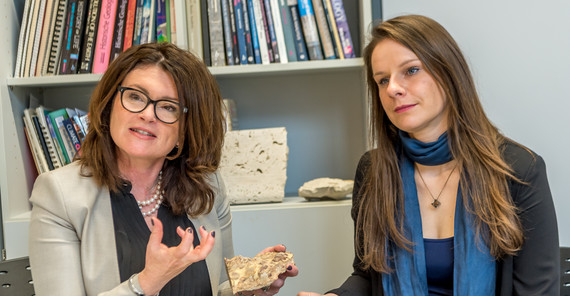Millions of years ago, rivers and seas helped shape the sediment layers of geological basins. Some of these layers were then covered by further deposits, while others were pushed up by mountain rock folding. Research on a sedimentary basin in the Andes is expected to offer new insight into which geological processes were involved.
When setting off for work, Wera Schmidt must make sure she has three things: sunscreen, a compass, and a hammer. As a geologist, her fieldwork periodically takes her to the Jujuy region in the Andes Mountains in northwestern Argentina, where she spent five weeks in March and April 2017. In the field, at an altitude of over 4000 meters, her trained eye easily spots what she is looking for: seemingly inconspicuous brownish rocks with rounded moldings. With her hammer she takes samples, and with her magnifying glass she studies their macroscopic properties. These rocks, though, are anything but inconspicuous: They are stromatolithes, i.e. fossils of ancient colonies of microorganisms. Stromatolithes have existed for 3.7 billion years, making them the oldest oxygen-producing organisms on Earth. The ones that Schmidt finds in Argentina are 65 million years old.
Rock structures provide insight into geological processes
The area where the geologist works contains rocks formed millions of years ago. It is part of the Salta basin, which covers several hundred square kilometers of northwestern Argentina. Tres Cruces – Three Crosses – is the name of this sub-basin. The oldest deposits here date back to when dinosaurs roamed the earth. Where the Andes now stand, there used to be a water-covered plateau. “Whether this was an ocean of seawater or a large freshwater lake, we don’t know yet,” says Maria Mutti, Professor of Sedimentology and head of the project.Answering this question is a main objective for Schmidt, who is doing her doctorate in the “StRATEGy” PhD program. Where are the rock formations that interest her? What are their dimensions? What types of rock do they comprise, and what factors contributed to them being deposited where they are now? It requires a bit of Sherlock Holmes work, Schmidt says.
The young scientist analyzes some of the rock samples in a Brazilian laboratory and others in Potsdam. Last year, she brought a total of 60 kilograms to Potsdam. “Each type of rock needs a particular sedimentation environment,” the doctoral student explains. In the laboratory, the samples undergo various chemical analyses, are sliced ultra-thin, and analyzed under a microscope down to the micrometer. The geoscientists determine the age of the various rock formations, which structures they contain, and what conclusions can be drawn with regard to environmental and climatic parameters. They also create a 3D model of the sediment layers in the basin, which they had previously measured with a GPS locator. The model will ultimately even show the progression of sediment formation over time.
Working in the high mountains requires physical fitness – and good preparation
The team around Schmidt and Mutti includes two researchers from Argentina, Prof. Dr. Claudia Galli and Prof. Dr. Beatriz Coira. The four drove an off-road vehicle through the mountains, inspected the area, and discussed the work ahead. An all-female team – a rarity in science.
For their own safety, the researchers have to always keep an eye on the high-mountain weather. “This year, the coastal El Niño on the Pacific side of South America brought one storm front after another,” Schmidt describes the danger. There were cherry-sized hail, material damages, landslides, and debris avalanches. “Nobody wants to be in the field then.” Physical fitness is also required: the researchers have to climb steep slopes and cope with the thin mountain air that causes headaches, nightmares, and shortness of breath.Schmidt spends weeks and months in the field for her studies. “Forget all you think you know about Argentina,” she says with a laugh. She lives in the simplest of conditions, alternating between a small, old, countryside hotel and a cabin in a mining village. “There is no red wine, tango, or steak.” Instead, you get insight into the indigenous people’s lives, which are determined by spirituality and the rhythm of the seasons. Enviable scenic views of nature make up for the lack of comfort.When the researchers looked at their rock samples under a microscope, they were thrilled to discover ooids – small grains of calcite. It is very rare to find them along with stromatolithes. “An unusual, surprising constellation,” which makes the geologists wonder what they will find next, Mutti explains. Their findings might also be of commercial interest: In Brazil, large oil deposits were found below sediments similar to those of the basin in Argentina – by chance.
The Researchers
Prof. Dr. Maria Mutti studied earth sciences at the University of Bologna and the University of Milan (Italy) as well as geology at the University of Wisconsin (USA). Since 2002, she has been a professor at the University of Potsdam. Her research focuses on limestone.
Universität Potsdam
Institut für Erd- und Umweltwissenschaften
Karl-Liebknecht-Str. 24–2514476 Potsdam
maria.muttiugeo.uni-potsdampde
Wera Schmidt, M.Sc., studied geosciences at the University of Bochum. Since 2015, she has been participating in the “StRATEGy” PhD program at the University of Potsdam.
wera.schmidtugeo.uni-potsdampde
The Project
StRATEGy (SuRfAce processes, Tectonics and Georesources: The Andean foreland basin of Argentina) is a German-Argentinian PhD program researching the formation processes of sediments in Argentina.Participants: University of Potsdam, Helmholtz Centre Potsdam – German Research Centre for Geosciences (GFZ), University consortium of Buenos Aires, University consortium of Salta – Jujuy – TucumánFunding: German Research Foundation (DFG), Consejo Nacional de Investigaciones Científicas y Técnicas (CONICET)Duration: 2015–2018http://www.irtg-strategy.de/index/
Text: Heike Kampe
Translation: Monika Wilke
Published Online by: Alina Grünky
Contact to the online editorial office: onlineredaktionuuni-potsdampde
Read this and other articles on research at the University of Potsdam in our research magazine Portal Wissen.

